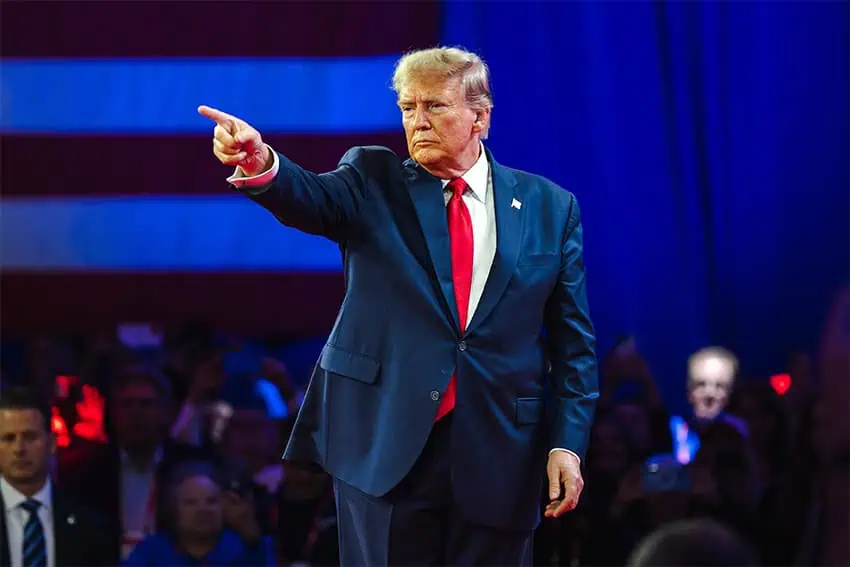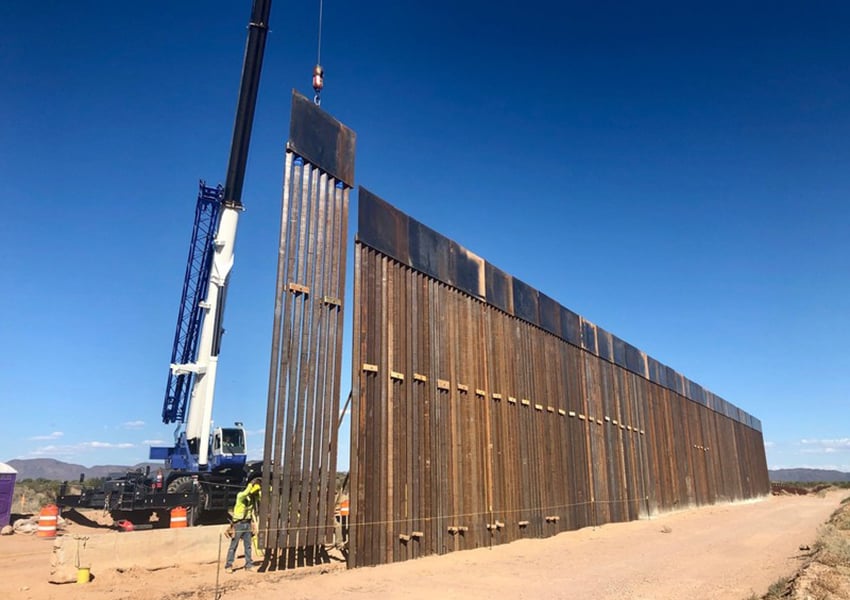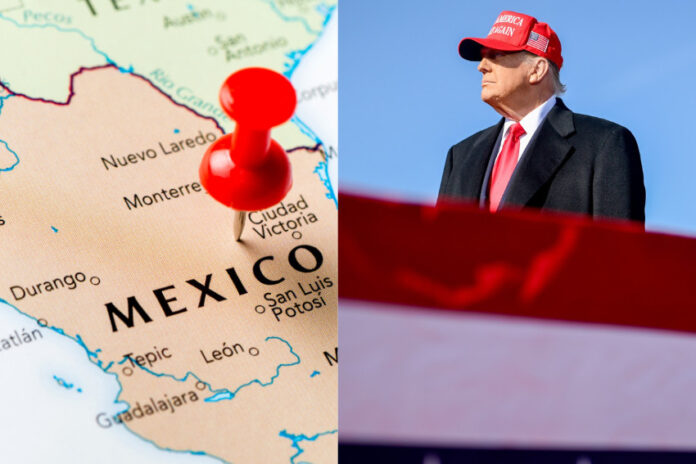Just hours after his inauguration as the 47th president of the United States, Donald Trump signed a number of executive orders directly related to Mexico.
At least some of those orders have the potential to have a significant impact on the Mexico-United States relationship, especially in the early period of Trump’s second presidency.

President Claudia Sheinbaum said on Tuesday that she will maintain “a cool head” and respond “step by step” to the actions taken by Trump on the first day of his second term.
Here is a summary of five Mexico-related executive orders Trump signed in the Oval Office of the White House on Monday night.
1. Emergency at the United States’ southern border
Trump signed an executive order “Declaring a national emergency at the southern border of the United States.”
“That’s a big one, a lot of big ones, huh?” Trump said after an aide announced the order he was about to sign.
The declaration of an emergency at the United States-Mexico border allows the president to access funding for border wall construction without approval from the U.S. Congress.
In the executive order, Trump said that “America’s sovereignty is under attack.”
“Our southern border is overrun by cartels, criminal gangs, known terrorists, human traffickers, smugglers, unvetted military-age males from foreign adversaries, and illicit narcotics that harm Americans. … This invasion has caused widespread chaos and suffering in our country over the last four years,” he said.
Among the directives Trump issued in his executive order were the following:
- The deployment of the U.S. military “to support the activities of the Secretary of Homeland Security in obtaining complete operational control of the southern border of the United States.”
- The construction of “additional physical barriers along the southern border.”
- The prioritization of “the impedance and denial of the unauthorized physical entry of aliens across the southern border of the United States.”

The New York Times reported Monday that involving the U.S. military in border security tasks “would draw immediate legal challenges because of the strict limits in American law for how the armed forces can be deployed inside the country.”
2. Drug cartels could be designated as foreign terrorist organizations
Trump signed an executive order “Designating cartels and other organizations as foreign terrorist organizations and specially designated global terrorists.”
“Within 14 days of the date of this order, the Secretary of State shall take all appropriate action … to make a recommendation regarding the designation of any cartel or other organization described in section 1 of this order as a Foreign Terrorist Organization,” the order said.
The terrorist designation will likely apply to powerful Mexican criminal organizations such as the Sinaloa Cartel and the Jalisco New Generation Cartel.
“That’s a big one,” Trump said just before signing the executive order.
“People have wanted to do this for years. So they are now designated as terrorist organizations foreign. Mexico probably doesn’t want that but we have to do it. … They’re killing our people, they’re killing 250,000 to 300,000 American people a year, not 100 [thousand] like has been reported,” he said referring to drug overdose deaths.

Trump’s executive order said that “the Cartels have engaged in a campaign of violence and terror throughout the Western Hemisphere that has not only destabilized countries with significant importance for our national interests but also flooded the United States with deadly drugs, violent criminals, and vicious gangs.”
It also said that “it is the policy of the United States to ensure the total elimination of these organizations’ presence in the United States and their ability to threaten the territory, safety, and security of the United States through their extraterritorial command-and-control structures.”
Asked whether he would consider “ordering U.S. special forces into Mexico” to “take out” cartels, Trump said it “could happen.”
“Stranger things have happened,” said the president, who last year indicated he was open to using military “strikes” against Mexican cartels.
3. Trump orders resumption of Remain in Mexico policy
The 47th U.S. president also signed an executive order entitled “Securing our borders.”
“My Administration will marshal all available resources and authorities to stop this unprecedented flood of illegal aliens into the United States,” Trump said in the order.
In it, he ordered the resumption of Migrant Protection Protocols, as the Remain in Mexico policy was formally known.

The policy, implemented by Trump during his first term as president, required asylum seekers who arrived at the Mexico-United States border to remain in Mexico as they awaited U.S. immigration court hearings. The Mexican government is opposed to the reactivation of the policy, which would appear to hinder Trump’s plan.
In his “Securing our borders” executive order, Trump also ordered the Secretary of Homeland Security to “cease using the ‘CBP One’ application as a method of paroling or facilitating the entry of otherwise inadmissible aliens into the United States.”
An update on the CBP One website states that “effective January 20, 2025, the functionalities of CBP One that previously allowed undocumented aliens to submit advance information and schedule appointments at eight southwest border ports of entry is no longer available, and existing appointments have been cancelled.”
In another executive order — “Guaranteeing the states protection against invasion” — Trump directed that the entry of “aliens engaged in the invasion across the southern border” be suspended “until I issue a finding that the invasion at the southern border has ceased.”
4. Trump orders renaming of the Gulf of Mexico
In his inauguration speech, Trump declared that “a short time from now, we are going to be changing the name of the Gulf of Mexico to the Gulf of America.”
Around seven hours later, he signed an executive order “Restoring names that honor American greatness.”
Florida Governor Ron DeSantis (R) is already recognizing the “Gulf Of America” in an official executive order pertaining to an emergency winter weather order. pic.twitter.com/DHZx91vFnp
— Ryan Saavedra (@RealSaavedra) January 20, 2025
In addition to ordering the reinstatement of the name Mount McKinley (the mountain in Alaska was renamed Denali in 2015), Trump directed that the Gulf of Mexico be renamed the Gulf of America.
“Within 30 days of the date of this order, the Secretary of the Interior shall … take all appropriate actions to rename as the ‘Gulf of America’ the U.S. Continental Shelf area bounded on the northeast, north, and northwest by the States of Texas, Louisiana, Mississippi, Alabama and Florida and extending to the seaward boundary with Mexico and Cuba in the area formerly named as the Gulf of Mexico,” the executive order said.
The order also said that “the area formerly known as the Gulf of Mexico has long been an integral asset to our once burgeoning Nation and has remained an indelible part of America.”
5. Trump sets the stage for tariffs on Mexican exports
Among a large number of presidential actions on his first day in office, Trump also issued an “America First Trade Policy” memorandum.
As we reported here, Trump said on Monday night that his administration could impose a 25% tariff on Mexican and Canadian exports to the U.S. on Feb. 1.
No day one tariffs, but orders signed directing Pres Trump officials to deliver reports to him on “unfair trade practices”, “currency manipulation” and “discriminatory” foreign taxes.
Here’s the full text – America First Trade Policy.https://t.co/L8jRfJIhQ0
— Louise Byrne News (@LouiseByrneNews) January 21, 2025
The president’s trade policy memo directed the Secretary of Commerce to “investigate the causes of our country’s large and persistent annual trade deficits in goods, as well as the economic and national security implications and risks resulting from such deficits, and recommend appropriate measures, such as a global supplemental tariff or other policies, to remedy such deficits.”
President Claudia Sheinbaum has said that her government will seek to avert the proposed tariff on Mexican exports through dialogue with the Trump administration.
Gabriela Siller, director of economic analysis at Mexico’s Banco Base, said on X on Tuesday that it is “highly unlikely that Trump will impose a general 25% tariff on all products from Mexico, at least not for a long period of time.”
“A 25% tariff would be equivalent to leaving the USMCA,” she said.
“This would mean a structural change for the Mexican economy that would result in a severe recession, job losses, an increase in [employment] informality to rates above 60% and an increase in public insecurity,” Siller said.
She also warned that a 25% tariff on Mexican exports to the U.S. would result in “increases in the exchange rate to historic maximums,” i.e. a significant weakening of the Mexican peso against the US dollar.
For the United States, a 25% tariff on Mexican exports “would mean supply change disruptions, a sharp rise in inflation, a higher interest rate and lower economic growth,” Siller said.
Mexico News Daily
